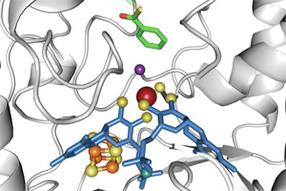 Scientists of the Freiburg University have discovered how bacteria break down aromatic compounds in anaerobic conditions. The bacteria use an enzyme which contains a tungsten atom (dark red) to destabilize an aromatic ring (green).
Scientists of the Freiburg University have discovered how bacteria break down aromatic compounds in anaerobic conditions. The bacteria use an enzyme which contains a tungsten atom (dark red) to destabilize an aromatic ring (green).Tungsten is the heaviest metal with a biological function.
Because aromatic compounds are very common in nature, it is important to know how they are recycled in the carbon cycle. This is especially the case since crude oil contains such compounds which are hard to break down and often toxic and carcinogenic.
How bacteria break down aromatic compounds in environments without oxygen was however unknown until now. Such environments can be river and lake sediments, contaminated ground water or biogas installations. Knowing tungsten's key role may enable addition of tungsten(compounds) to help bacteria break down aromatic contamination, or increase energy production in biogas installations. Also tungsten containing biocatalysts may be developed that can be used to produce specific compounds out of aromatic compounds that currently can only be produced using toxic substances.
No comments:
Post a Comment